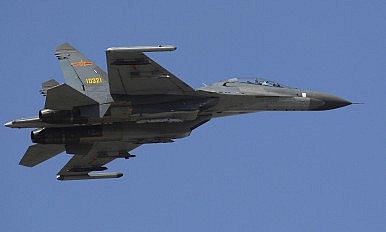By Robert Farley
 The Achilles Heel of China’s Air Force (PLAAF) has long been its lack of practical experience, both in combat and in deployments distant from Chinese borders. For the time being, a concentration on regional defense has served the PLAAF well. But as China’s interests and responsibilities grow, the air force may need to spin up the capabilities necessary to send its people and aircraft far away, for a long time.
The Achilles Heel of China’s Air Force (PLAAF) has long been its lack of practical experience, both in combat and in deployments distant from Chinese borders. For the time being, a concentration on regional defense has served the PLAAF well. But as China’s interests and responsibilities grow, the air force may need to spin up the capabilities necessary to send its people and aircraft far away, for a long time.
A recent RAND report highlighted the problems facing the PLAAF, as well as its effort to develop solutions in response to them. The report described the extent of the PLAAF’s international experience, as well as its performance in recent domestic support operations that involved the use of long-range transport. The report concluded that while China’s air force has increased its expeditionary capacity, it remains well behind the US Air Force (USAF) and many European air forces.
Several developments will accelerate the growth of China’s expeditionary capabilities. First, new heavy transports are coming into service that will facilitate the shipment of equipment, parts, and personnel necessary for long-range deployments. Second, China has stepped up participation in international exercises and demonstrations, laying the groundwork for longer deployments. Third, China has become aware of the shortcomings of its air forces in domestic relief operations, and is taking steps to remedy those deficiencies.
Expeditionary deployments, like most other military operations, require a tremendous component of tacit knowledge: knowledge that only comes from experience. In contrast to the Chinese situation, the United States has nearly a century’s worth of experience in the deployment of expeditionary airpower, if we count the occupation of the Philippines and the deployment of Army aircraft in World War I. Since World War II, the Air Force has operated from a far-flung constellation of air bases around the world, enabling it to maintain a nuclear deterrent, fight limited wars, and conduct the Wars on Terror. China would be hard pressed to develop a similar presence, at least in the short term.
The sale of Chinese military equipment abroad may also facilitate the development of expeditionary capabilities within the PLAAF. Weapon transfers almost invariably require personnel on the ground for training, operations, and maintenance, especially as the sophistication of systems grows. This means that Chinese personnel will increasingly get experience with the officers, facilities, and languages of foreign partners. This will undoubtedly grease the wheels when China wants to conduct something akin to an expeditionary deployment of air assets.
Where exactly the PLAAF would deploy to? The military installation in Djibouti springs to mind, as does Pakistan. However, as China’s economic interests around the world grow, Chinese people and property can potentially come under threat from war, disaster, or other mishaps. An expeditionary air force can offer either humanitarian assistance/disaster relief (HADR) in such situations, or a means for affecting the political situation. In any case, we should expect that the PLAAF will steadily increase its expeditionary capabilities parallel to the increase in China’s worldwide responsibilities.
No comments:
Post a Comment